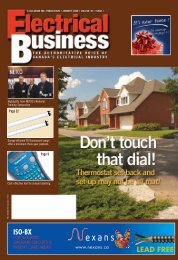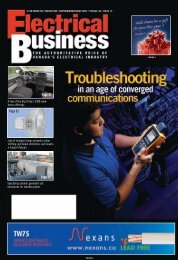Download - Electrical Business Magazine
Download - Electrical Business Magazine
Download - Electrical Business Magazine
You also want an ePaper? Increase the reach of your titles
YUMPU automatically turns print PDFs into web optimized ePapers that Google loves.
WIRINGfor the information ageHOW TO WIRE ETHERNETPhoto © Judith Howcroft.By David Herresot long ago, wiring a residence or commercialfacility consisted of putting in theNright service and running branch circuitsfor lighting and other connected loads.At a certain point, telephone companiesstopped furnishing indoor equipment.That installation became the responsibilityof the owner, who could delegate it toonsite electricians or specialized telecom workers.In recent years, a large amount of other low-voltage workentered the mix, and non-power and light wiring constitute agood part of any new construction and renovation. There areplenty of cabling contractors well qualified to do this work,but since the traditional electrician is usually first onsite, lowvoltagework can be part of the overall electrical contract.An important focus in upscale residential and most commercialbuilding is the networking of computers and relatedequipment—notably Internet connectivity with multiplecomputers and printers. This type of setup is known as aLAN (local area network), and is generally confined to onebuilding (although a campus matrix is also common).The connectivity is usually accomplished through aningenious protocol known as ‘Ethernet’. This name evokesthe idea of universality, which is very appropriate consideringthat this important tool has been used worldwide formany years and shows no sign of being replaced by anycompeting technology.It’s not at all necessary for those wishing to wire Ethernetto understand the inner workings of this protocol, though alittle background is interesting and provides perspective onthe undertaking.What is Ethernet?At the heart of Ethernet is the acronym CSMA/CD, whichstands for Carrier Sense Multiple Access Collision Detect.This mouthful describes the Ethernet process. Each connectedentity in the network is continually ‘listening’ to determinewhether there’s data activity. When there’s no traffic, it is okayto transmit. In the event that two or more members of thenetwork begin transmitting at the same time, data streams willcollide and neither will be successful. Both halt transmission,then wait a random amount of time before retransmitting. Itis this protocol that makes Ethernet communication possible,though there are other elements to it, as well.There are two types of Ethernet elements: data terminalequipment (DTE) and data communication equipment(DCE). You can think of the former as providers and consumers,such as computers and printers, and the latter asfacilitators, such as hubs, switches and routers. Which of theseare being connected determines the wiring pin-out, whichwe’ll get into below.The other part of the equation is the Ethernet medium,most commonly unshielded twisted pair (UTP) or fiber optic(FO) cable. The original Ethernet ran on a serial coax busline, but this setup is considered obsolete.Traditional electrical work is serial in nature, colloquiallytermed ‘daisy chain’; branch circuit power comes from anovercurrent device in an entrance or sub panel, goes to thefirst device, such as a receptacle, then to the next, and so on.Photo of Cat 6 RJ45 connector © Bomar.TIA/EIA mandates RJ 45 pinouts for Ethernet connections.Looking at a connector with the clip to the back and wireopening down, there are eight terminals numbered 1-8starting at the left. For straight-through wiring, TIA 568-Bis used at both ends. For crossover wiring, T 568-A isused at one end and T 568-B at the other.TIA 568-ATerminal 1 – green/whiteTerminal 2 – greenTerminal 3 – orange/whiteTerminal 4 – blueTerminal 5 – blue/whiteTerminal 6 – orangeTerminal 7 – brown/whiteTerminal 8 – brown(Spiderwebbing—the practice of bringing power to a singlejunction box, then splicing out lines to the outlets—is consideredbad form.)In contrast, the preferred configuration for telephone andEthernet is star topology, where each branch is wired back tothe source. Although this configuration consumes more cable,it ensures there are no extra splices; splicing is undesirablebecause it disrupts the twisting of paired conductors, which iscrucial for counteracting inductive loss. Indeed, when terminatingUTP it is important that no more twists are eliminatedthan necessary.You can successfully wire Ethernet without knowing IEEE802.3. It is sufficient to understand that this protocol isPhoto of 60807 compression crimping tool © Greenlee.TIA 568-BTerminal 1 – orange/whiteTerminal 2 – orangeTerminal 3 – green/whiteTerminal 4 – blueTerminal 5 – blue/whiteTerminal 6 – greenTerminal 7 – brown/whiteTerminal 8 – brownAn unused RJ 45 connector is shown at top left. Bottom left isa cut-down connector used to straighten and prepare UTP endsbefore crimping. Top right is cable prior to this process. Bottomright is afterwards, ready to insert in new connector.contained within and implemented by Ethernet cards (NIC),which are required at both ends of any Ethernet link wherethey interface to the media (cabling). Ethernet cards are backwardcompatible, but there is a specialized version for fiberoptic cable, which terminates differently. (The mechanics ofoptical fiber are beyond the scope of this article. We’ll stickto copper cabling, which—in Cat 5e and later versions—iscapable of speeds and reliability appropriate to most networkscurrently being installed.)Installing category cablingThe first thing to consider is the type of cable to use and howit is to be installed. With regard to the installation method,raceway is not required for most environments. You can secureUTP to any wood finish surface but, for drywall, it is necessaryto use screw clips fastened through the plaster layer intostuds. Where a finish appearance is important, Wiremoldworks well. Where possible, it is best to conceal the cable usingfishtapes, chain, magnets and other electrician tools. In newconstruction, drill through studs and other framing prior toinsulation and wallboard. Do not place Ethernet wiring inthe same hole or close to power wiring.Though not required, premium results can be obtained byusing electrical metallic tubing (ETM) in commercial work.This versatile metal raceway is coupled and terminated witheasy setscrew fittings (or, for wet areas, compression fittings).A conduit bender creates gentle sweeps and EMT connectorsgo into box knockouts. Grounded metal raceway protectsagainst RF radiation, including harmonics, both incomingand outgoing. EMT provides fire protection as well, andanother advantage is that when the cabling becomes obsoletein the future, it can be used to pull optical fiber into place.However the installation is accomplished, it is essentialnot to damage the media (cable). UTP cable is fairly rugged,but any kinking, pinching or abrading can, at the very least,compromise connectivity (though the same fault would notdegrade a lower frequency telephone hookup). Also, don’t letanyone step on the cable as it is being run out of the carton.Do not use previously installed cable—save these pieces fortelephone circuits. Similarly, small wirenuts or crimpable bugsare suitable for telephone work but Ethernet circuits requiresplice-free runs.There are several UTP parameters to keep in mind:Solid versus stranded. UTP is available in both versions.Solid is used for a permanent installation whereas stranded isbetter for short patchcords that will be bent repeatedly. Solidhas better high-speed performance. It is important to use thecorrect connector type. Both are of the insulation displacementtype. The stranded variety pierces the conductors whereas thesolid version slides past and presses against them.Plenum, riser, general purpose, limited use. The currentcarried in an Ethernet circuit is incapable of igniting combustiblematerial, but insulation and jacketing material ignitedby fire originating elsewhere can contribute to flame propagationand produce significant amounts of thick toxic smoke.Hence it is important to choose the cable according to theenvironment in which it will be installed.14 • NOVEMBER/DECEMBER 2008 • www. mag.com
















